RIGHT TURN ONLY!!
Naruto in Wonderland
by Carlo Santos,

No, I don't think the Apple iFeminineHygieneProduct is going to do much to revolutionize the age of digital readers for comics and manga. Either everyone still prefers physical copies (including freeloading at Borders/Barnes), or everyone who reads comics digitally has already figured out how to do it on their own computers just fine.
What I really don't get is why people in Japan apparently prefer to squint at cell phone screens that do injustice to the art at that size and resolution.
ALICE IN THE COUNTRY OF HEARTS

Vol. 1
(by QuinRose x Soumei Hoshino, Tokyopop, $10.99)
FROM THE BACK COVER:
"Wonderland is officially at war! And Alice is trapped in the middle of it all. Will she make it out alive? A little arrogant, stubborn, and determined to get back home, Alice isn't fazed by these challenges ... until she discovers that every man is gun crazy and weirdly in love with her. What's going on in Wonderland?!"
EVIDENCE FOR:
Does the world really need another interpretation of Alice in Wonderland? Apparently, yes! (Tim Burton thinks so too.) This manga-fied Alice is surely more coherent than CLAMP's Miyuki-chan in Wonderland attempt, and the stylishly re-imagined bishounen characters—from the Mad Hatter to Tweedledee and Tweedledum to even the White Rabbit—should be an instant draw for the target audience. But what will really grab perceptive readers, and prove that this is more than just a shallow act of fanservice, is the way it satirizes the entire reverse-harem concept. "This is a world that you desired," says one of Wonderland's pretty-boy denizens, "a world where everyone is in love with you." Could it be that this series is skewering the fandom the way Lewis Carroll skewered Victorian culture in the original? Think about it! And in the meantime, enjoy the nonsense and fantasy that is very much in the spirit of Carroll's work: crazy guys pulling magical transforming guns on each other, insults being traded at rapid fire, and people and places that are never quite what they seem. All this, rendered in a style that's visually appealing and easily readable? Now that's a Wonderland worth visiting.
EVIDENCE AGAINST:
Here's the trouble with doing Alice: unless you're some kind of genius, it's almost impossible to surpass the original (the Disney film probably came the closest, and that was because it followed the book quite strictly). Otherwise, the overlaying of genre gimmicks on top of Wonderland just makes it look, well, gimmicky. One could spend the entire first half of this volume fawning over the pretty boys, but eventually there comes the realization that, hey, there's still no actual story yet. After the "rules" of Wonderland are finally explained, it does add some depth and brings in the satirical element, but the interactions between the characters still haven't evolved anywhere beyond Alice wanting to go home and all the guys wanting Alice. The addition of a turf war between various regions of Wonderland also turns out to be a cardboard premise; there's really no political or conspiratorial element aside from the fact that everyone hates each other due to this territorial divide. If the humor is basically lots of lookalike pretty boys mouthing off at each other, that's going to get old real fast. Plus Ouran did it better anyway.
FINAL VERDICT:
An imaginative idea with some amusing points, but if the story insists on being as weak (or non-existent) as it is, then this is stuck in C territory for now.
DEADMAN WONDERLAND
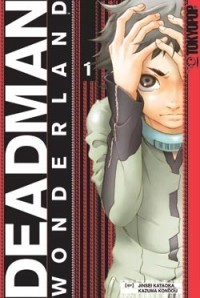
Vol. 1
(by Jinsei Kataoka and Kazuma Kondou, Tokyopop, $10.99)
FROM THE BACK COVER:
"The Great Tokyo Earthquake. Ten years ago, it destroyed lives as it tore buildings asunder. Among those who lived through the disaster was Ganta Igarashi, now a middle school student finally getting a footing in his own life ... that is, until the day the 'Red Man' appears at his school and turns his world upside down again. Ganta's entire class is brutally murdered, and although innocent of the crime, Ganta is sentenced to death and sent to the bizarre prison known as 'Deadman Wonderland.' There, a brutal game of survival begins, where Ganta must discover the truth behind his classmates' murder.
Can Ganta break out of Deadman Wonderland ... or will it break him first?"
EVIDENCE FOR:
As a post-apocalyptic vision of the future, Deadman Wonderland may not seem like the most original thing in the world, but what it's really doing is melding different post-apocalpytic ideas to create an entirely new beast. A natural disaster, a privatized penal system pushed to the extreme, humans treated like commodities, a hidden technological conspiracy, and a young boy fighting for survival amongst the dregs of society—it's as if nature, commerce, culture, and the human condition all broke down at the same time ... and ended up in this spot. And while it may seem like a dark, shocking story, Ganta's determination and his drive for justice provide a glimmer of hope in this negative world. Rooting for a hero with lots of friends is nice, but rooting for a hero who's got the whole world against him is something even more gripping. The intense artwork also adds to the experience, with high contrasts, dizzying angles and harsh imagery that bring the Deadman world to life. Just check out the "dog race" in Chapter 3, which is as thrilling as they come, and proves that even a tale of no hope can be a charged-up experience.
EVIDENCE AGAINST:
Sometimes, throwing together a bunch of cool-sounding ideas can backfire on a story—especially when the story decides that exploring those ideas is a secondary concern, compared to some all-style-no-substance action-adventure plot. Much of the prison's bizarre punishment rules, for example, seem like a contrivance designed to keep the plot going: "you'll die in three days if you don't consume some vital item that is ridiculously difficult to acquire!", or something like that. So much for thoughtful critique on the judicial system. Even the very earthquake that sparks off the series feels like an arbitrary addition—how, exactly, did that event have anything to do with a 14-year-old boy being wrongfully thrown in jail? The characters that Ganta meets are similarly lacking in depth; it'd be nice if someone could explain the role of somethine like Shiro, who plays the obligatory moe-moe girl and long-forgotten childhood friend (apparently even the post-apocalyptic future is not safe from annoying ero-game tropes). There's a whole world just waiting to be explored, and instead we get mindless bursts of action that could be had from any other series.
FINAL VERDICT:
Maybe it's not yet time for digging into the heart of the story. But as a gripping introduction to a hard-boiled future world, it still gets a B-.
NARUTO
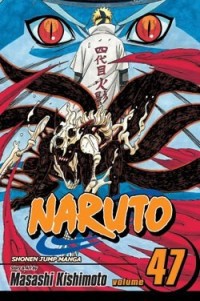
Vol. 47
(by Masashi Kishimoto, Viz Media, $9.99)
FROM THE BACK COVER:
"Naruto is a young shinobi with an incorrigible knack for mischief. He's got a wild sense of humor, but Naruto is completely serious about his mission to be the world's greatest ninja!
Naruto inches ever closer to discovering the true identity of his nemesis, Pain. But is it worth it as the frustrated ninja begins to morph at last into the dreaded Nine Tails? Plus an unexpected confession reveals incredible secrets about his past as Naruto prepares for the ultimate battle with Pain. Can the chakra-challenged Naruto win when one misstep could spell disaster?"
EVIDENCE FOR:
It's probably too soon to suggest that Volume 47 the defining moment in Naruto—but it is, to be sure, one of the most profound. It is here that Naruto confronts the very meaning of his existence, not to mention meeting a vital figure from his past. It's hard to imagine a boys' action series being philosophical, but Naruto's showdown with Pain is exactly that: how, exactly, does he intend to achieve peace and justice? How can he end a never-ending cycle of hate? And what does it mean to be a great ninja, a great hero, a great person? These are ideas that don't just resonate with the series' target audience, but with all of humanity. Amid such deep thoughts, however, there's still room for good old ninja action: Naruto's solution for gathering senjutsu chakra (which was hinted at previously) is a stroke of genius, his attacks bristle with verve and energy, and when the time comes to unleash the Nine-Tailed Beast ... well, Masashi Kishimoto has clearly been practicing for this moment, with his full artistic arsenal on display. This volume delivers in just about every aspect, and it looks like the next one could be just as awesome.
EVIDENCE AGAINST:
Someone's getting a little bit trigger-happy with the heroic deaths and sacrifices. Yes, this is the deadliest attack that's ever been waged on Konoha, but when the author keeps throwing random characters into the line of fire, it lessens the impact with each fallen comrade. Let's stay focused on Naruto fighting the battle of his life, shall we? Ah, but even that part of the story has its drawbacks: with so many lookalike foes (the multiple incarnations of Pain), and so much collateral damage (the village having essentially been reduced to rubble), looking at the art can be like looking at one of those eye tests for color blindness. Except in black and white. Only in the latter part of the volume, when the fight is narrowed down to Naruto versus a single Pain, does it achieve a better level of visual coherence. But there's still the issue of the loopy video game logic that pervades this whole affair—"he's vulnerable for 5 seconds between jutsus" and "be careful of that one guy who deflects all jutsu attacks" stuff that sounds more like a Zelda boss than a climactic showdown.
FINAL VERDICT:
A bit sloppy in some of the fight scenes, but when things are getting as exciting (and emotionally moving) as this, it can't be anything less than an A-.
RIN-NE
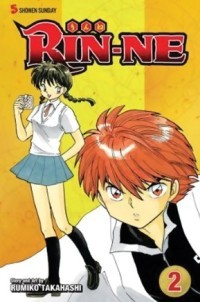
Vol. 2
(by Rumiko Takahashi, Viz Media, $9.99)
FROM THE BACK COVER:
"After a mysterious encounter in her childhood, Sakura Mamiya gained the power to see ghosts. Now a teenager, she just wishes the ghosts would leave her alone! Then one day she meets Rinne Rokudo, a boy who is far more than what he seems.
Sakura and Rinne deal with the ghosts of an ancient warrior and a girl who drowned in the school swimming pool, but that's just a warm-up! A wandering spirit leads them to a surprising confrontation, one that takes Sakura and Rinne on an even more amazing chase!"
EVIDENCE FOR:
The high school supernatural spirit-hunting genre may be one of the most overdone in recent years, but when a legendary manga-ka with a three-decade-long resume has a go at it, you'd best shut up and pay attention. Once again Rumiko Takahashi shows just how it's done, with clever stories that bring together classic folk tales and whiz-bang adventure. The highlight of this volume is none other than a literal Battle in Hell, where Rinne meets up with an old rival for a spiritual shootout involving all sorts of unique (and sometimes hilarious) weaponry. Takahashi's imagination and sense of humor are on full display here, from the very gates of Hell—designed to look and operate just like a subway station—to the infernal depths where victims are doomed to washing dishes for all eternity. Even the way Rinne fights (hmm, what to do with a giant stack of yen bills?) is witty in its own way. The series' unique style is further enhanced by Takahashi's retro yet refreshing artwork, where clean, restrained lines can still give rise to massive, eye-catching monsters—and you don't have to stare at a page for half a minute to decipher what's going on. Now that's real genius.
EVIDENCE AGAINST:
As they say, it's okay to do something that's been done before as long as you do it well—but even a living legend sometimes struggles within the constraints she's set for herself. Which is to say, sometimes Takahashi dwells too much upon the "done before" aspect of the supernatural genre. Like a ghost who haunts the school swimming pool? Really? I don't care if you invented swimming pools; that one's appeared in so many stories that even the best plot twist in the world can't get the musty stuck-in-the-closet smell out of that one. In fact, the entire first half of this volume (plus the first act of the Battle in Hell) mires itself deeply in repetitive formula—Volume 1 already made it pretty clear that Sakura and Rinne's job is to help spirits move on to the next world, so it ought to be time for some serious adventures already, not helping third-string characters with their petty spiritual problems. And it'd help if those adventures showed more visual flashiness than the dry, flat artwork that sometimes plagues the series.
FINAL VERDICT:
A thrilling battle ups the ante after some run-of-the-mill ghost stories, which spells a B ranking for this volume.
SHUGO CHARA!
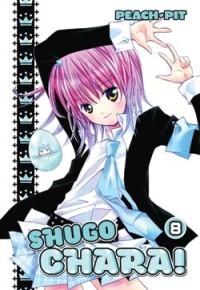
Vol. 8
(by Peach-Pit, Del Rey, $10.99)
FROM THE BACK COVER:
"Ikuto has disappeared, and it's up to Amu and her fellow Guardians to save him. But what about Tadase's mysterious past with Ikuto? And what does that mean for Amu and Tadase's relationship? Plus, Rima learns the truth about Nagihiko's double life!"
EVIDENCE FOR:
Believe in your friends who believe in you! Did Shugo Chara suddenly turn into Gurren Lagann? No, it's simply switching gears back to hot-blooded magical combat mode, which is exactly what the series needs after the emotionally taxing Amu/Ikuto/Tadase mess. That love triangle gets put on hold while Amu and friends fire themselves up and get back on track—a track that leads to plenty of thrilling Character-Transforming action as our heroes and heroines try to save a lesser evil (the ever fascinating, morally conflicted Ikuto) from a greater evil (the Easter Corporation). At the same time, though, this volume sees one of the absolutely essential flashbacks in the series—Tadase explaining his troubled childhood with Ikuto and Utau. In just twenty pages, the story suddenly becomes that much richer, and all the fighting that comes afterwards suddenly has a deeper meaning to it. But of course, it wouldn't be a fight worth seeing unless it were visually appealing, and that's where the unique artistic style comes in—very delicate and ornamented, yet filled with bold, energetic designs. Kind of like Nagihiko, who steals in the show in the last chapter and proves that Shugo Chara! still holds many surprises in store.
EVIDENCE AGAINST:
While the events of this volume may be great for filling up one's heart with excitement, those of us who read with our brains may find these latest developments lacking. The one example of tight storytelling is in the flashback, which fills in plenty of vital gaps, but the remaining pages are a loosely-strung collection of battle scenes, lucky coincidences, and ho-hum dialogue. There are really only about three ways to say "believe in your friends and do your best," and this volume repeats those lines over and over like a broken record. Meanwhile, it seems that Amu keeps getting last-minute saves from everyone she's ever met: Ikuto about to strike you down? Here's Tadase to the rescue! Easter Corporation guards trying to stop you from breaking into company headquarters? Don't worry, your friends in the entertainment industry will bail you out! How are we supposed to watch our heroine gather her courage and stand up for herself when people keep leaping in out of nowhere to rescue her? The power of friendship is a beautiful thing, but not when it gimps the story and makes the main character ineffectual.
FINAL VERDICT:
Although packed with cool magical fight scenes and one vital flashback, it doesn't quite make the jump from good to great—so this one's stuck on B right now.

CROWS
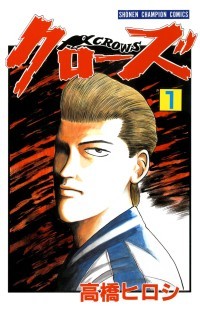
Vol. 1
(by Hiroshi Takahashi, Akita Shoten, ¥390)
SUMMARY:
Suzuran High School is an all-boys school notorious for its gangs and delinquents—a place so chaotic that it is nicknamed "the Crows' School." However, the balance of power at Suzuran is shaken up when a newcomer named Bouya Harumichi transfers in and proves to be a deadly fighter. Will Bouya be the one to stand up to the ganglords that hold the school in their iron grip?
EVIDENCE FOR:
It was a time when men were men, when shônen manga meant fists and pride and honor and not simpering little schoolgirls. Yes, Takahashi's Crows is one of those series where it's worth it just to see the lead character kick ass and take names. No ninja powers, no magical swords, no yelling out names of attacks ... just dour-faced schoolboys duking it out bare-handed. With bold lines and dramatic gestures, each fight is a little work of art in itself; Takahashi makes maximum use of speedlines and pure physics to show just how hard Bouya can hit (you wouldn't want to stand in the way of a punch that can send a guy flying 50 feet). Yet for all its preening, tough-guy attitude, Crows sets itself apart from the pack with its sense of humor—Bouya spends more time acting like a flake than a fighter, and it turns out he's more interested in dating the sister of the class weakling than actually bringing punks to justice. In a world where the guy who screams incessantly "I want to be stronger!!!" is often the hero, it's refreshing to see someone who steps into the role with a laid-back groove.
EVIDENCE AGAINST:
You know, if this fella is just going to go around beating up delinquents at random, maybe it would be better if it were a regimented tournament scheme with increasingly difficult opponents and victory going to guy who wants to be stronger. For all its manly burning passion, the first volume of Crows is in dire need of an actual story—at least something more than "new student transfers in and starts fighting everyone." It's hard to get invested in a fight when the motivating factor is something as shallow as two guys looking at each other the wrong way. How about a little back story, some childhood rivalry, deep-seated hatred, anything? And it's not just in their personalities where the characters are underdeveloped—the actual character designs are also lacking in variety, and there are only so many variations you can do on pompadour hairstyles and sneering faces before they all start to look the same. It's never a good thing when one has to look at a fight scene and think, "Did that guy just punch Bouya or was it the other way round?" The passion is there; now let's see the craftsmanship to go with it.
FINAL VERDICT:
A bit rough around the edges, but for a good old beat-'em-up with a touch of humor, this one is definitely worth a look.

In an age where many publishers are on the fritz, the "Whatever Happened To THAT License?" pile continues to grow. In the first installment of a two-part series, Ben Jonas talks about an action-comedy that he'd like to see revived from the dead! (And who am I to disagree with a fellow Bleach fan?)
MAMORU THE SHADOW PROTECTOR (KAGE KARA MAMORU!)

(by Taro Achi and Sai Madara, DrMaster, $9.95 ea. / Media Factory, ¥500 ea.)
What if Uryu Ishida (from Bleach) was a ninja in disguise, and what if Orihime Inoue (also from Bleach) was the girl he was assigned to protect? Sound good so far? If it gets more people to read Mamoru the Shadow Protector, then I'll keep on pointing out the characters' similarities to those of their Bleach counterparts.
Based on a series of light novels created by Taro Achi, and written and illustrated by Sai Madara, the light novels' original illustrator and cover artist, Mamoru the Shadow Protector (or Kage Kara Mamoru) follows the adventures of Mamoru Kagemori, a ninja disguised as an apathetic nerdy high school student who, since childhood, has been assigned the task of guarding cute-but-ditzy Yuna Konnyaku (who shares more than a few personality traits with Bleach's Orihime). This is no ordinary task, however, as the Kagemoris have been protecting the Konnyakus for 400 years (even Mamoru's family is involved, as his father, Kengo, watches over Mr. Konnyaku at work, and his mother, Sakurako, looks after Mrs. Konnyaku while employed part-time at the same convenience store where she works). On top of that, Mamoru must keep his identity secret, never letting Yuna (or her friend, Airi—think Tatsuki) know that he's really part of a family of ninjas.
Over time, more characters get involved, such as swordswoman-for-hire Tsubaki Mapputatsu (imagine a more-serious Rangiku), who enrolls in the same high school as Mamoru and Yuna, only to find her old-fashioned manners make her feel out of place (even though she's a skilled assassin, she constantly dreams of being a normal girl, even imagining being surrounded by hot guys when she tries to join the school's tennis team). Even the family dog, Bullmaru, gets involved (sorry, Akamaru, but only Bullmaru can take down an entire room full of assassins single-pawedly). The situations themselves get further out of hand, ranging from fighting an ordinary gang of mobsters to fending off an army of killer zoo animals (quite possibly the biggest highlight of the first volume).
By the second half of the second volume, however, the series starts to veer into harem territory. Although Yuna entering an idol contest (and Tsubaki dreaming about it to the point where she's already preparing her autographs) is the book's major highlight, Tsubaki going on a "date" with Mamoru and the introduction of Mamoru's "sister" Yamane (think Momo or Yachiru, with attitude) drags things down a bit. The introduction of transfer student and Yamane's rival Hotaru in the third volume (sorry, no real comparisons there) reinforces the harem cliché (though the looks on Yuna and Airi's faces after Hotaru proposes to date Mamoru are priceless). It isn't until the second half of the third volume that things start to get back on track, when aliens who can't even pronounce the name of their home planet kidnap Yuna.
The artwork is nice and sharp, yet simple (Yuna's goofy-yet-cute grin will melt even the coldest of hearts). And though it may sound cliché, seeing Yuna struggle with her emotions when she hears that Mamoru is going on a date with Hotaru is somewhat refreshing (as opposed to the cliché "girl hits guy, guy goes flying or gets a giant bump, girl runs away in tears" schtick). The humor, however, is what makes the book shine. From the ridiculous assortment of villains that Mamoru faces off against, to Mamoru's family making life more difficult for him with each passing chapter (Sakurako's hearing is so good, she and Kengo hold a large celebration when they get word that Hotaru confessed to their son), the situations the characters are put through may be odd, but are quite entertaining.
DrMaster Publications published the first three volumes of the series, with the third one coming out in December 2008 and the fourth one slated for the spring of 2009. However, DrMaster completely fell off the radar after publishing the sixth volume of Lunar Legend Tsukihime (another underrated manga worth checking out) back in February 2009. Since then, they have not published a single thing, made any updates to their website, or even made any comments on their Facebook page (the Forums section of their homepage has been disabled). Since they appear to be down and out, here's hoping that Yen Press will give the series a second chance (it would go nicely with Sumomomo Momomo). Failing that, there's always the possibility of the Kage Kara Mamoru anime getting picked up (which I haven't seen yet, so I'm not quite sure if I can recommend it, especially since the manga was published one year after the anime aired). Should neither of those things happen, then I'll have to resort to pulling more references to Bleach out of thin air (whatever it takes to have the series get noticed and finish its run).
Is there a hidden gem of manga you'd like to reveal to the world? Is there a piece of garbage that deserves to be bashed in public? Or is there a title that didn't get a fair grade here, and you want to set the record straight?
Now's YOUR chance to be the reviewer! Write a review of about 300-400 words (a little more or less is fine) and include:
- Your name
- Title of manga (and volume no., if applicable)
- Author/Artist
- Publisher
- Briefly describe the story, then explain why this manga is great, terrible, or in between. Be objective, but also be entertaining.
Then send it in to rtoreaders (at) gmail (dot) com (plain text format preferred). One review will be selected out of all the submissions and will be published in the next column. All types of manga and manga-inspired comickry are accepted, from past and present, from Japan and beyond—what matters is that it's the Reader's Choice! NOTE: Submissions may be edited for formatting and grammar.
discuss this in the forum (17 posts) |